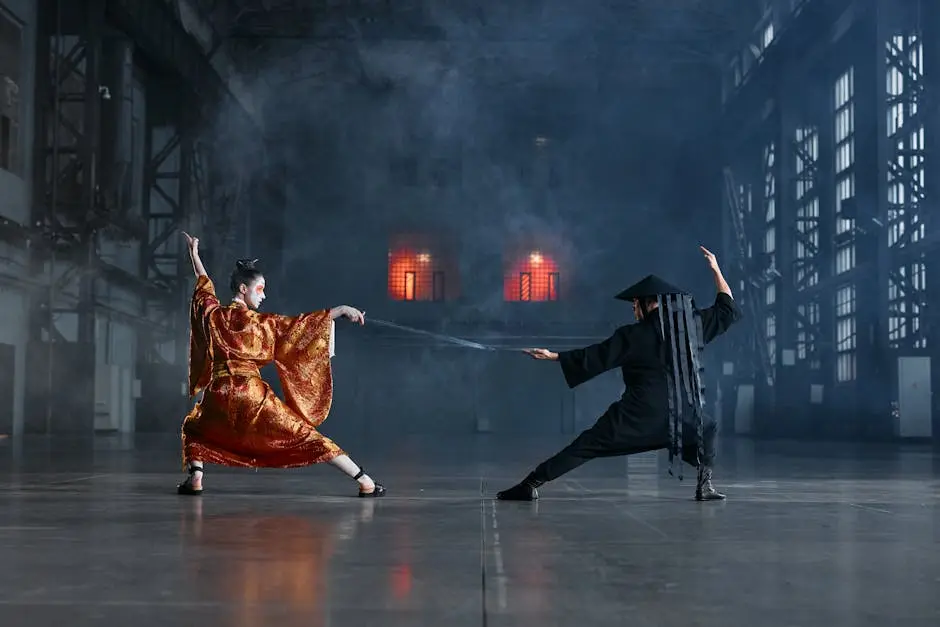Kung Fu has captured the hearts of audiences worldwide with its breathtaking and intricate fight scenes. In this blog, we will take a closer look at some of the most iconic kung fu fights in cinematic history, exploring their impact on film and martial arts culture. From classic showdowns to modern masterpieces, let’s dive into the art of kung fu and its legendary fight sequences that have defined the genre.
The Rise of Kung Fu Cinema
In this section, we will explore how kung fu cinema originated and gained popularity in the 1970s, highlighting key films and actors that contributed to its rise.
The 1970s marked a pivotal moment for kung fu films, ushering in a craze that transcended borders. Early on, films like “The Big Boss” and “Fist of Fury” featuring Bruce Lee captivated audiences. These films weren’t just entertainment; they were cultural phenomena that introduced a new genre, showcasing not only impressive fight sequences but also compelling storytelling. Lee’s charisma and mastery of martial arts set a benchmark for others, inviting viewers into a world where honor, discipline, and physical prowess reigned supreme.
Moreover, the release of “Enter the Dragon” in 1973 opened the floodgates for kung fu films in Hollywood. It brought kung fu to the forefront of global pop culture. Lee’s iconic performance blended incredible fight choreography with a gripping storyline, making kung fu fighting accessible and interesting to a Western audience. This crossover success laid the groundwork for future martial artists and filmmakers to emulate his style and spirit.
As the decade progressed, other influential figures emerged, contributing to the genre’s momentum. Actors like Jackie Chan introduced humor and acrobatics into their fight scenes, creating a unique blend of martial arts and comedy. Films like “Drunken Master” showcased his innovative style, further expanding the appeal of kung fu films. This combination of thrilling action and light-hearted storytelling drew in a diverse audience, ensuring that kung fu cinema would continue its ascent.
Iconic Fight Scenes: A Closer Look
Here, we will analyze some of the most memorable kung fu fight scenes, discussing their choreography, filming techniques, and the emotions they evoke.
One of the most memorable fight scenes in kung fu history is found in “The Matrix”. While it may not be a traditional kung fu film, it expertly integrates martial arts into its narrative. The iconic dojo fight between Neo and Morpheus perfectly encapsulates the blend of contemporary cinema with traditional martial arts. The choreography brilliantly showcases the fluid movements of kung fu, highlighting not only combat techniques but also the philosophical and transcendent aspects of martial arts. It leaves audiences exhilarated and pondering the deeper meanings of freedom and choice.
Additionally, the fight scene in “Crouching Tiger, Hidden Dragon” is a visual feast. The graceful choreography, combined with breathtaking cinematography, elevates the kung fu fight to an art form. The use of wire work allows characters to defy gravity, creating an ethereal quality to the battles that feels poetic rather than purely combative. This contrast is what makes the fight scenes in this film unforgettable. Audiences are transported into a world where martial arts expresses emotions that words cannot.
On a different note, the warehouse fight sequence in “The Raid” shows a raw, visceral approach to combat. Though not strictly a kung fu film, it incorporates various martial arts styles. The relentless pace and high stakes evoke a different kind of emotion—intensity and urgency that keep viewers on the edge of their seats. This scene highlights the evolution of fight choreography, where the focus shifts from stylized movements to a more gritty portrayal of combat, reflecting modern influences while retaining the essence of martial arts.
The Influence of Bruce Lee
Bruce Lee revolutionized kung fu cinema with his unique fighting style. This section will delve into his most famous scenes and how they changed the film industry.
When we speak of the influence of Bruce Lee on kung fu and its portrayal in cinema, we cannot overlook the iconic fight in “Way of the Dragon” against Chuck Norris at the Colosseum in Rome. This classic matchup brought together two martial arts titans in a showdown that would be remembered for ages. Lee’s intense focus and innovative techniques contrasted beautifully against Norris’s formidable presence. The choreography captured not only the physical prowess of both fighters but also a philosophical undercurrent about respect and honor in martial arts. This scene set a standard for fight choreography that is studied and admired even today.
Moreover, Lee’s ability to convey deep emotion through his fights redefined the narrative potential of action scenes. In films like “Fists of Fury,” the emotional weight he brought to every confrontation blurred the line between action and drama. Lee’s fights weren’t merely about showcasing martial arts techniques; they served as a narrative device, conveying anger, determination, and ultimately, the quest for justice. This ability to engage audiences on a deeper level resounded strongly within the film industry, challenging future filmmakers to infuse similar elements into their works.
Modern Interpretations of Kung Fu Fights
We will look at how contemporary filmmakers are reinterpreting traditional kung fu themes and fight choreography, showcasing films that blend modern techniques with classic elements.
Today, we see a fascinating fusion of traditional kung fu and modern filmmaking in films such as “Kung Fu Panda”. This animation doesn’t just entertain; it also educates younger audiences about the philosophies of kung fu. The film’s fight sequences are energetic and, while animated, maintain the essence of traditional martial arts. The character of Po embodies the struggle and perseverance central to kung fu, making it relatable for viewers of all ages while introducing them to the art form.
Another prime example is found in the work of directors like Yuen Woo-ping, who brought kung fu to the forefront of action cinema with films like “The Matrix” and “Kill Bill”. Through innovative choreography and a willingness to blend various styles—from traditional kung fu to modern martial arts—Yuen has revitalized the genre for a new generation. These films showcase how the fluid motions of kung fu can be adapted to fit contemporary narratives, while still respecting the roots of the martial art. It highlights the ongoing evolution and relevance of kung fu in the dynamic landscape of cinema.
Cultural Impact and Global Reach
This section will examine how kung fu fights in cinema have influenced global culture, sparking interest in martial arts and their representation across different media.
The cultural impact of kung fu fights cannot be understated. From inspiring fitness trends to influencing fashion, the iconic imagery of kung fu has permeated various aspects of life worldwide. Consider how popular video games and animated shows often incorporate kung fu elements, tapping into the rich visual language cultivated by decades of cinema. This crossover not only showcases the enduring popularity of kung fu but also highlights its versatility in storytelling, making it accessible to diverse audiences across different cultures.
Furthermore, kung fu’s representation has sparked dialogues about cultural heritage and identity. As filmmakers around the world adopt and reinterpret these themes, they create space for discussions on authenticity and respect in the portrayal of martial arts. This cultural exchange is vital—not only does it promote understanding, but it also fosters a deeper appreciation for kung fu as both an art form and a way of life. Ultimately, the legacy of kung fu cinema is intertwined with its ability to transcend boundaries, connecting people through shared admiration for the discipline and artistry that define this remarkable martial art.
Reflecting on the Enduring Legacy of Kung Fu in Cinema
The legacy of these legendary kung fu fights goes beyond mere entertainment; they have shaped martial arts cinema and inspired countless fans and filmmakers alike. As we celebrate these iconic moments, we remember the dedication and artistry that bring each scene to life. Whether you’re a lifelong kung fu aficionado or a newcomer to the genre, these legendary fights offer a glimpse into the remarkable world of martial arts on screen.


